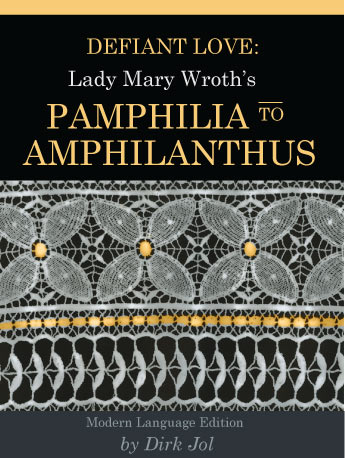Defiant Love:
Lady Mary Wroth’s Pamphilia, to Amphilanthus
→ Biography of Lady Mary Wroth


In the 16th and early 17th centuries, women didn’t publish non-religious works, unless they were prepared to pay the price.
Like Shakespeare’s Sonnets, Lady Mary Wroth’s song-and-sonnet cycle, Pamphilia, to Amphilanthus, only ever received a single printing in its time. It was appended to the large romance novel she published in called The Countess of Montgomery’s Urania (named after her aunt, Mary Sidney, who was the Countess of Montgomery at the time). Wroth’s novel caused a scandal because members of the court recognized themselves in her novel. She was forced to withdraw the book from publication, and she withdrew from court to live in relative obscurity for the rest of her life.
When Wroth published her poems, they must have seemed passé and unremarkable to men, despite having been written by a woman. Their seemingly conventional nature would barely have raised an eyebrow among male readers. But for many women, reading Wroth’s poems must have been a ground-breaking experience because she strove to create a separate gender sensibility.
Wroth’s writing was informed by her observations and experiences at court, where she participated in the making of tableaux and masques, popular forms of Jacobean court entertainment. Wroth used her experience in these genres to create a narrative of female desire in a surprising and surreptitious way.
The Modern Language Edition of Pamphilia, to Amphilanthus will appeal to readers who have difficulties with early modern English but still want to gain a strong grasp of the contents on first reading.
As published in 1621, Lady Mary Wroth’s Pamphilia, to Amphilanthus consists of a mix of sonnets and songs. The individual poems have been labeled with the letter ‘P’ in the manner used by noted Wroth scholar Josephine Roberts.
You may purchase an ebook (epub or mobi) of the entire 1621 version in the original wording at a nominal cost of US $1.99 by clicking on the following button:
Wroth has left the legacy of manuscript copies of many of her own works. Below are text versions of the undated manuscript copies in the Folger Shakespeare Library. The Folger collection includes six poems that were not included in Pamphilia, to Amphilanthus; these are included at the end with their unique ‘F’ numbers.
Josephine A. Roberts, The Poems of Lady Mary Wroth, Baton Rouge: Louisiana State University Press, .
Naomi J. Miller and Gary Waller, (eds.), Reading Mary Worth: Representing Alternatives in Early Modern England, Knoxville: University of Tennessee Press, .
Naomi J. Miller, Changing the Subject: Mary Worth and Figurations of Gender in Early Modern England, Lexington: University Press of Kentucky, .
Susan Lauffer O’Hara, The Theatricality of Mary Worth’s Pamphilia to Amphilanthus: Unmasking Conventions in Context, Selinsgrove: Susquehanna University Press, .